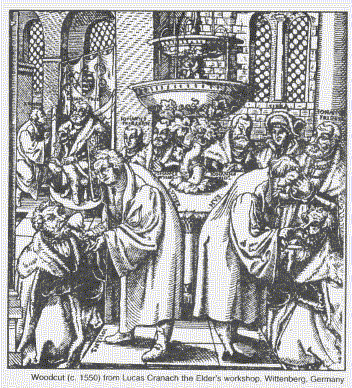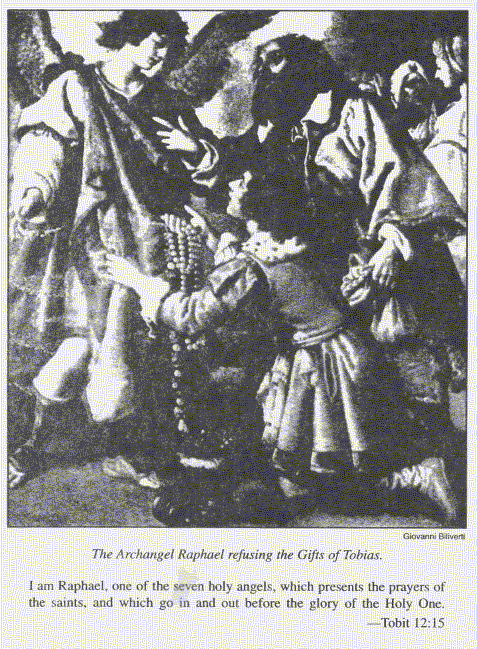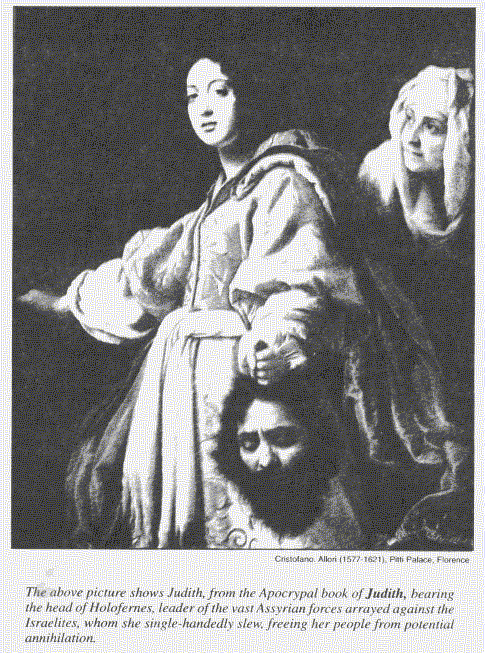


| rosanista.com | ||
| Simplified Scientific Christianity |



Most American Bible owners have either the King James or some other Protestant version. A great many of them believe this indeed to be the complete Bible. Unless, that is, they have seen the Douai (also spelled Douey) or some other Catholic version, which has not 66, but 80 books. Between the Old and New Testaments, there are 14 additional books, the Apocrypha.[1] The questions arise: Why are they not in the Protestant Bibles? How or why were they removed? Do they belong in the canon of Biblical books? A summary of pivotal facts will help the reader draw his own conclusions.
In the 3rd century B.C., some 70 or 72 Greek-speaking Jewish scholars in Egypt, at the request of Ptolemy II, prepared what has come to be known as the Septuagint (from the word 70) Version of the Old Testament. It included the Apocrypha. This was the Old Testament used by Our Lord and the apostles, and unreservedly endorsed by the early church fathers. "Our Scriptures do not include the . . . apocryphal books. . . .Yet the boy Jesus must have been familiar with them, and He remembered them in His manhood, for they are quoted in His speeches recorded in the New Testament, and the ante-Nicene Church accepted them."[2]
In 382 A.D. a scholar we know as Jerome was commissioned by Pope Damasus to revise the Latin version of the Bible, which we know as the Vulgate.[3] The apocryphal books were a part of it. For more than a millennium it was indisputably the Bible of the Church. When Wyclif and Purvey prepared the very first English translation of the Bible, 1382-1388, the apocryphal writings were retained. This was also true of the first German translation of the Latin text made at about the same time.
The very first Bible issued with the Apocrypha set apart was in 1520, in Wittenberg, Germany, by one Andreas Bodenstein, known better by the name of his native town, Karlstadt, and a follower of Martin Luther. He added a note to the effect that these books were "worthy of the censor's ban" — inferior. It was a Latin Bible.
The very first Bible in a vernacular — the Dutch — that segregated the apocryphal books, placing them all after the Old Testament, appeared in 1526 in Antwerp. It also included a note calling attention to the opinion that they were inferior to the other books. In 1530 a similar Swiss version appeared; both had been issued by non-Catholics.
In 1534 Luther's German translation of the complete Bible came out. Again these 14 books were together, right after Malachi, with a preface: "Apocrypha—that is, books which are not held equal to the Holy Scriptures, and yet are profitable and good to read." He did not explain who had determined that these writings "are not held equal," or why. The following year the first Bible in French was printed by Pierre Robert Olivetán near Neuchâtel, Switzerland. The Apocrypha was included, as also in later French editions. The great French Protestant reformer John Calvin quoted from the Apocrypha — though only 10 times, whereas 4,000 times from other portions — and never to support doctrinal positions. Also in 1535 the first English Bible appeared, printed by Myles Coverdale. The 14 apocryphal books were all ensconced between the Old and New Testament. Thus also in all of the following Protestant English Bibles: the Matthew Bible of 1537; the Taverner Bible and the Great Bible of 1539; and the (Puritan-produced) Geneva Bible of 1560.
Meanwhile, to stem the Protestant revolt, the Roman Catholic Church had convened the Council of Trent (1545-63). There, the apocryphal writings received the strongest possible endorsement. Naturally, this was not going to be left unnoticed by the Protestants, though the reaction would come with surprising slowness. Thus, the Protestant Anglican
Prayer Book of 1549 still accept the Apocrypha. Thirteen years later, the English government issued a most interesting document, the Thirty-Nine Articles of Religion, defining official orthodoxy. This was the time of Queen Elizabeth I, whose transcendent aim was to end religious controversy as part of her Via Media (Middle Way). Accordingly, Article VI can be interpreted as anti-apocryphal; Article XXXV as pro-apocryphal.
In 1581 the first Slavonic (Russian) Bible was issued. Here, the apocryphal books were distributed throughout the Old Testament. But the Russian Orthodox Church gradually shifted its position until, by 1839, its Longer Catechism excluded the Apocrypha from the Old Testament altogether.
Turning our attention once more to the West, we find that in 1599 new editions of the Geneva Bible began to omit the 14 books. This was a time of high tide for the Puritans; they had set out to "purify" the Church of England of all things they called "Romish." That included the books so singularly supported by the Council of Trent 53 years before. As the noted scholar Sir Frederick Kenyon put it, "the Puritans persecuted the Apocrypha."[4]
But 1611 was a year of low tide for the Puritans, and that was when the King James Version appeared. The King James who had sponsored this translation[5] was the same who had caused many Puritans to flee to America. This version included the Apocrypha. Not only that, but in 1615 George Abbot, Archbishop of Canterbury and thus the Church of England's "acting leader" under the King, threatened anyone printing a Bible without the Apocrypha with a year in jail! But the "omitters" of the Apocrypha had a big advantage. Bibles without the Apocrypha had a competing edge — they could be offered for sale at a lower price. And due to the unsettled conditions in England under Charles I (1625-49) and the return of Puritan ascendancy under the Cromwell Commonwealth (1649-59), Abbot's edict was not enforced. Bibles without the Apocrypha were circulated in big numbers. Except among one group, the mystics. In the spirit of Christian love, they sympathized with the Puritans' aspirations, even though they had been persecuted by them, but considered the disputed 14 books to be on the same level with the other 66.[6]
Surely one of the major ancillary Biblical publications for many years has been Cruden's Concordance. Its first American edition (1806) contained a special section for the Apocrypha; later editions started to omit it. One reason may have been that in 1827 both the British and American Bible societies, which had been including the Apocrypha in their Bibles, stopped doing so. Yet as late as 1894, when the English Revised Version of the Bible came out, the 14 books were included in some editions, though in smaller print.
A little known but significant event occurred in 1901, when England's Edward VII was crowned. At the very last, just before the monarch was to kiss the Bible before signing the coronation oath, it was discovered that the Bible, dutifully provided by the British Bible Society, lacked the Apocrypha. Another one with the Apocrypha was quickly procured, for the law of the United Kingdom still required an 80-book Bible to be used at royal installations.[7]
It cannot be denied that over the years the apocryphal books have exerted considerable cultural influence. England's famous poet of the 7th century, Caedmon, used excerpts. So did Chaucer, seven centuries later, in his celebrated Canterbury Tales and other writings.[8]
Columbus was influenced by the Apocrypha to set sail in 1492! It is a well-known fact that he was swayed by Pierre d'Ailly's Imago Mundi (shape of the world) to believe not
only that the earth is round, but also that only one-seventh of the earth's surface is covered by water, so the fabled lands to the west couldn't be very far away. This notion was based on an erroneous interpretation of II Esdras 6:42, 47, 50, 52 by d'Ailly.
Shakespeare's plays include over 80 references to the Apocrypha,[9] though it may be mere coincidence that two of his daughters were named after apocryphal heroines, Susanna and Judith. John Milton also was indebted to these books. For instance, his Paradise Lost has references to the Wisdom of Solomon, even as the American Transcendentalist Nathaniel Hawthorne can be tied to II Maccabees.
Every year at Christmas, millions sing "Silent Night, Holy Night" and "O Holy Night." Yet in Luke 2:11 we read that Jesus was born "this day." Whence the popular belief in a nocturnal nativity? It can be traced to the early church fathers' interpretation of Wisdom 18:14-16. Art connoisseurs know that Judith, Tobit, Susanna, and Holofernes have all inspired masterpieces. Their stories are all in the Bible's disputed books.
Even from this greatly abbreviated overview some undisputable facts emerge: for over three-fourths of the Christian era, the Apocrypha was universally accepted, and exerted a powerful cultural influence. There's also this: the huge 400-year gap between the Old and New Testament. If one were to read a history of the U.S. that had omitted events between the Civil War and World War II — less than one fifth the time span between Malachi and Matthew — one would at once realize something was missing. The same is true if one reads an Apocrypha-less Bible. As a famous theologian, while still a Protestant, put it: "Providence never acts with harsh transitions, one thing melts into another. Day melts into night, summer into winter." And the Apocrypha "melts," or joins, the two Testaments.[10]
In the margin of the 1611 King James Version, there are no less than 113 references to related passages in the Apocrypha; 102 in the Old Testament 11 in the New.[11] To mention just one: John 10:22 tells of the Feast of Dedication; I Maccabees 4:59 relates its post-Old Testament origin. And there can be no doubt that the Apostle Paul borrowed heavily from the Apocrypha in his Epistle to the Romans.[12]
There's no better way to consider the relationship of the Apocrypha to the rest of the Bible than to read it. One will thereupon wonder on what basis the 14 books were excluded from the other 66. It is often said that they are not of the devotional quality as the rest. Of course this is a very subjective way of passing judgment. But aren't there many portions of the 66 books that can be said to be lacking in the same way? How about the Old Testament genealogies and the stories of the many bloody wars? It is also a fact that John Bunyan, famous author of Pilgrim's Progress, at a time of spiritual despondency found balm for his soul after searching the Bible for "above a year" in Ecclesiastes 2:10.[13] It might also be noted that a devout group of Protestant Christians has directed its clergy, at weddings, to read not only from the Old and New Testaments but also from the apocryphal book of Tobit, for it "presents a beautiful lesson which strengthens the pious and God-fearing in the earth, especially as regards marriage."[14] Admittedly, the Apocrypha can be said to be "different." But this is really a vague claim. The other 66 books are also quite different from each other. In the Old Testament we have the historical books, the wisdom literature, the major and minor prophets. Some parts of even just one book of the 66 are very different, which is why, for instance, "Chapters
forty to fifty five of the Book of Isaiah are known as the Deutero-Isaiah . . . Not of Isaiah's authorship but the work of another."[15] In the New Testament there are the Gospels, Acts, Epistles, and Revelation. Ruth and Revelation are very different, also Chronicles and Corinthians, Proverbs and Philippians. Anyone bent on denigrating the Apocrypha needs to be reminded that parts of the Old Testament, were they to be made into films, would get an X rating at best, yet they are not questioned. Is this consistent?
Perhaps the master key to what belongs in the Bible and what does not is found in this statement: "The increasing wonder of the Bible is found in the fact that actual physical events are used to conceal profound spiritual truths."[16] Can there be any other viable basis for allowing certain portions of the Old Testament into the Biblical canon? Is there any other way in which the many seeming contradictions of the Bible, based on a literal interpretation, can be harmonized?
Because of its role as the link between the Old and New Testament, Bible students suffer a loss by neglecting the Apocrypha — but an even greater one by ignoring the key to comprehending all three — the esoteric approach as set forth by Mystic Christianity. The Western Wisdom literature has numerous references to the Apocrypha.[17]
"The word Apocrypha can also mean that the writers of the books intended their meaning to be cryptic or apparent only to the initiated. There was much writing of this sort in the period just before and after the beginning of the Christian era.
"Those acquainted with extra-canonical Scriptures aside from the Apocrypha will be interested that `the Pseudepigrapha,' or the `falsely inscribed' Scriptures, are not fraudulent; the false inscription is merely a device . . . by which a later writer could express his ideas under the shelter of an earlier and accepted writer's name."[18]
— A Probationer
4. The Story of the Apocrypha, Edgar J. Goodspeed, p. 6.
5. That is why the preface, or introduction, still found in some editions of the King James Version, is so highly flattering of him.
6. Harvard Theological Review, Vol. XI (1947), pp. 177-205.
7. An Introduction to the Apocrypha, Bruce M. Metzger, 202.
8. "The Monkes Tale," lines 3757-64; "The Tale of Melbeus," lines 2185, 2235, 2848, etc.
9. Shakespeare and Holy Scripture, Thomas Carter; Shakespeare's Biblical Knowledge and Use of the Book of Common Prayer, Richard Noble.
10. Cardinal Newman's Doctrine of Holy Scripture, Jaak Seynaeve, pp. 50, 51.
11. Some examples:
Matthew 6:7 Ecclesiastes 7:14 Matthew 23:37 II Esdras
1:30
Matthew 27:43 Wisdom 2:15, 16 Luke 6:31 Tobit 4:15
Luke 14:13 Tobit 4:7
John 10:22 I Maccabees 4:59
Romans 9:21 Wisdom 15:7
Romans 11:34 Wisdom 9:13
II Corinthians 9:7 Ecclesiastes 35:9 Hebrews 1:3 Wisdom 7:26
Hebrews 11:35 II Maccabees 7:7
12. Romans 1:20,21 Wisdom 13:5, 8
Romans 1:22 Wisdom 13:1, 12:24
Romans 1:26 Wisdom 14:24
Romans 1:29 Wisdom 14:25, 27
Romans 9:20 Wisdom 12:12
Romans 9:21 Wisdom 15:
Romans 9:22 Wisdom 12:20
13. Grace Abounding, John Bunyan, section 62 ff.
14. Mennonite Quarterly Review, Volume XV, p.101.
15. New Age Bible Interpretation, Old Testament, Volume III, p. 212. Corinne Heline,
16. The New Age Bible Interpretation, Volume IV, The New Testament, Part II, Corinne Heline, 116.
17. The New Age Bible Interpretation, Old Testament, Volume I, Corinne Heline, pp. 65, 67, 94, 100, 101. Volume II, pp. 211, 212, 243, 379. Volume III, p. 293. The New Testament. Part I, pp. 36, 37. Part II, pp. 128, 152; Part III, p. 153.
18. The Meaning of the Dead Sea Scrolls, A. Powell Davies, p. 58.
Suggested further reading for elaboration and verification
of the above material:
The Apocrypha, an American Translation, Edgar J. Goodspeed.
The Story of the Apocrypha, Edgar J. Goodspeed. An Introduction
to the Apocrypha, Bruce M.
Metzger.
An Introduction to the Books of the Apocrypha, W.O.E. Oesterley.
The Shorter Books of the Apocrypha, J.C. Dancy. Between Athens
and Jerusalem, John J. Collins. The Pseudepigrapha and Modern
Research, James H. Charlesworth.
— Rays from the Rose Cross Magazine, September/October, 1995
|
Contemporary Mystic Christianity |
|
|
This web page has been edited and/or excerpted from reference material, has been modified from it's original version, and is in conformance with the web host's Members Terms & Conditions. This website is offered to the public by students of The Rosicrucian Teachings, and has no official affiliation with any organization. | Mobile Version | |
|